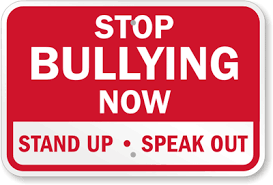|
What is bullying?
Bullying is unwanted, aggressive behavior among school aged children that involves a real or perceived power imbalance. In order to be considered bullying, the behavior must be aggressive and include:
(Retrieved from: www.stopbullying.gov) |
Are there different types of bullying?
There are three types of bullying:
|
|
When and Where Does Bullying Happen?
Bullying can occur during or after school hours. While most reported bullying happens in the school building, a significant percentage also happens in places like on the playground or the bus. It can also happen travelling to or from school, in the youth’s neighborhood, or on the Internet. (Retrieved from: www.stopbullying.gov) What are the Risk Factors? No single factor puts a child at risk of being bullied or bulling others. Bullying can happen anywhere—cities, suburbs, or rural towns. Depending on the environment, some groups—such as lesbian, gay, bisexual, or transgender (LGBT) youth, youth with disabilities, and socially isolated youth—may be at an increased risk of being bullied. (Retrieved from: www.stopbullying.gov) How Should you Talk To Your Kids About Bullying? Parents, school staff, and other caring adults have a role to play in preventing bullying. They can: Clicking on the hyperlinks will take you to the www.stopbullying.gov website where each of these methods are discussed in more detail.
|
How Should You Respond to Bullying?
How you respond can make an impact on bullying over time. Find out what you can do to stop it on the spot and support the kids involved. Stop Bullying on the Spot When adults respond quickly and consistently to bullying behavior, they send the message that it is not acceptable. Research shows this can stop bullying behavior over time. There are simple steps adults can take to stop bullying on the spot and keep kids safe. Find Out What Happened Whether you’ve just stopped bullying on the spot or a child has reached out to you for help, learn how to determine the best way to proceed. Support the Kids Involved All kids involved in bullying—whether they are bullied, bully others, or see bullying—can be affected. It is important to support all kids involved to make sure the bullying doesn’t continue and effects can be minimized. Be More Than a Bystander Every day, kids see bullying. They want to help, but don’t know how. Here are a few simple and safe ways that your child can help someone who’s being bullied and be more than a bystander. |
If you would like to report inappropriate behavior or a bullying situation that you witnessed or experienced at North Nodaway schools,, you are encouraged to contact a teacher, counselor, or administrator. Your identity will remain confidential. The administration will follow up on all concerns immediately. If the school isn't aware of a problem, they can't fix it, so please report the problem!!!
You may also call the Bullying Prevention Hotline for Missouri at 1-866-748-7047. This hotline provides students and parents with a place to anonymously report bullying, and also provides access to resources.
If you would like to leave an anonymous tip, please use the form below.
You may also call the Bullying Prevention Hotline for Missouri at 1-866-748-7047. This hotline provides students and parents with a place to anonymously report bullying, and also provides access to resources.
If you would like to leave an anonymous tip, please use the form below.

